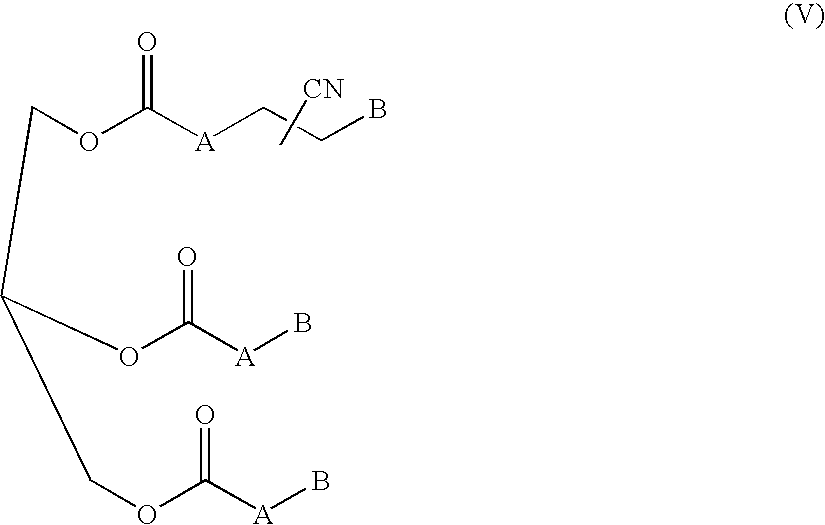Process of hydrocyanation of unsaturated carboxylic acid derivatives
a technology hydrocyanation process, which is applied in the field of hydrocyanation of unsaturated carboxylic acid derivatives, which can solve the problems of undesirable reported yield for commercial application, difficult reaction, and internal olefins
- Summary
- Abstract
- Description
- Claims
- Application Information
AI Technical Summary
Benefits of technology
Problems solved by technology
Method used
Image
Examples
example 1-4
Hydrocyanation of Oleic Acid
A solution of catalyst was prepared by combining Ni(COD)2 in toluene with a bidentate phosphite ligand in a ratio of Ni:ligand of 1:1.1. This solution was sampled into a reaction vessel. Oleic acid was added to the reaction vessel, the mole ratio of oleic acid to catalyst was 50:1. A solution of promoter was prepared by adding ZnCl2 to acetonitrile. This promoter solution was added to the reaction mixture adjusting a mole ratio of Ni to Zn of 1:1. Hydrogen cyanide was added to the reaction vessel via vapor feed. The hydrogen cyanide reservoir was at room temperature while the reaction vessel was maintained at 50° C. The vapor feed was maintained for 24 hours after which time the samples were analyzed using standard GC methodology for products. The samples were first derivatized for analysis with a commercial reagent following established procedures (BSTFA, bistrimethylsilyltrifluoroacetamide, for typical use see for example Takao, Yuji et al. in Journal...
example 5
Hydrocyanation of Soy Bean Oil
In a 100 mL flask soy bean oil (30 g) was mixed with a toluene (16 g) solution of Ni(COD)2 (0.31 g) and the following ligand (1.03 g):
To this was added ZnCl2 (0.045 g). A solution of hydrogen cyanide (2.85 g) in tulene (11.4 g) was prepared and added to the above mixture using a syringe pump. A feed rate of about 0.5 mL / hour was maintained at 70° C. The product composition was analyzed using LC-MS analysis on a Zorbax RX-C18 column (150×2.1, 5 μm) after the reaction was terminated: 70.1% conversion of soy bean oil to a mixture of products with 55% of MW=911 (addition of one equivalent of HCN), 35% MW=938 (addition of two equivalents of HCN) and 10% MW=965 (addition of three equivalents of HCN).
example 6
Hydrogenation of Soybean Oil Nitrile
A solution of approximately 30 g of nitrile derived from soybean oil (comprising compound V) and 170 mL of toluene was prepared. The solution was charged to a 300 cc stirred pressure reactor with 3 g Raney® Co 2724 and 4.5 g water. The vessel was purged with hydrogen and then charged with hydrogen and heated to 75° C. at which point the pressure was adjusted to approximately 500 psig (3447 kPa) with hydrogen. The reaction proceeded for ten hours during which hydrogen was constantly replenished to maintain the operating pressure. The hydrogen was vented and the product recovered. Infrared and nuclear magnetic spectra of the product were consistent with the formation of the amine product (comprising compound VI) (IR: N—H 3350 cm−1, C═O 1742 cm−1).
PUM
| Property | Measurement | Unit |
|---|---|---|
| Temperature | aaaaa | aaaaa |
| Temperature | aaaaa | aaaaa |
| Pressure | aaaaa | aaaaa |
Abstract
Description
Claims
Application Information
 Login to View More
Login to View More - R&D
- Intellectual Property
- Life Sciences
- Materials
- Tech Scout
- Unparalleled Data Quality
- Higher Quality Content
- 60% Fewer Hallucinations
Browse by: Latest US Patents, China's latest patents, Technical Efficacy Thesaurus, Application Domain, Technology Topic, Popular Technical Reports.
© 2025 PatSnap. All rights reserved.Legal|Privacy policy|Modern Slavery Act Transparency Statement|Sitemap|About US| Contact US: help@patsnap.com



